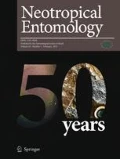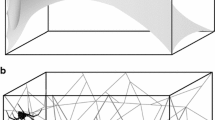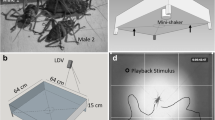Abstract
Embiopterans are among the least known of all insect orders, and yet their behavior is worthy of investigation for many reasons. They spin silk produced in glands in their front tarsi and live in groups, usually mothers with their young and sometimes in large colonies with many reproductive females sharing the silk. We discovered a large embiid (Clothodidae) in an Ecuadorian rain forest living under camouflaged silk sheets spun onto the bark of trees. Observations in previous studies of a related Trinidadian clothodid revealed that individuals shake and lunge their bodies in response to intruders of their silk domicile. We took the opportunity afforded by the discovery of the large clothodids to rear them in the laboratory and to investigate their communication behavior. We used piezoelectric film to detect substrate vibrations generated by adult females as elicited by a variety of intruders (an artificial stimulus, conspecific female or male, or a female of different species of webspinners). The residents produced three signals distinguishable by behavioral action, frequency (hertz), pulses per bout, and amplitude at peak frequency. We designated these as lift silk, shake, and snapback. Shakes varied the most in amplitude and frequency in response to the different intruders, and therefore, we propose that shakes may transmit the most information as individuals contact each other. This is the first report to characterize spectral qualities and contexts of substrate vibrations in an embiopteran.





Similar content being viewed by others
References
Bowen JL, Mahony SJ, Mason AC, Yack JE (2008) Vibration-mediated territoriality in the warty birch caterpillar Drepana bilineata. Physiol Entomol 33:238–250
Cocroft RB (1999) Offspring–parent communication in a subsocial treehopper (Hemiptera: Membracidae: Umbonia crassicornis). Behaviour 136:1–12
Cocroft RB (2001) Vibrational communication and the ecology of group-living, herbivorous insects. Am Zool 41:1215–1221
Cocroft RB, Rodriguez RL (2005) The behavioral ecology of insect vibrational communication. BioScience 55:323–334
Cokl A, Virant-Doberlet M (2003) Communication with substrate-borne signals in small plant-dwelling insects. Annu Rev Entomol 48:20–50
Cokl A, Virant-Doberlet M, Stritih N (2000) The structure and function of songs emitted by southern green stink bugs from Brazil, Florida, Italy and Slovenia. Physiol Entomol 25:777–794
Cokl A, Presern J, Virant-Doberlet M, Bagwell GJ, Millar JG (2004) Vibratory signals of the harlequin bug and their transmission through plants. Physiol Entomol 29:372–380
Collin MA, Camana E, Swanson BO, Edgerly JS, Hayashi CY (2009) Comparison of embiopteran silks reveals tensile and structural similarities across taxa. Biomacromolecules 10:2268–2274
Edgerly JS (1986) Behavioral ecology of a primitively social webspinner (Embiidina: Clothodidae: Clothoda urichi). Ph.D. thesis, Cornell University, p 167
Edgerly JS (1987a) Maternal behavior of a webspinner (Order Embiidina). Ecol Entomol 12:1–11
Edgerly JS (1987b) Colony composition and some costs and benefits of facultatively communal behavior in a Trinidadian webspinner, Clothoda urichi (Embiidina: Clothodidae). Ann Entomol Soc Am 80:29–34
Edgerly JS (1994) Is group living an antipredator defense in a facultatively communal webspinner (Embiidina: Clothodidae)? J Insect Behav 7:135–147
Edgerly JS, Tadimalla A, Dahlhoff EP (2005) Adaptation to thermal stress in lichen-eating webspinners (Embioptera): habitat choice, domicile construction, and the potential role of heat shock proteins. Funct Ecol 19:255–262
Edgerly JS, Shenoy SM, Werner VG (2006) Relating the cost of spinning silk to the tendency to share it for three embiids with different lifestyles (Order Embiidina: Clothodidae, Notoligotomidae, and Australembiidae). Environ Entomol 35:448–457
Fletcher LE, Yack JE, Fitzgerald TD, Hoy RR (2006) Vibrational communication in the cherry leaf roller caterpillar Caloptilia serotinella (Gracillarioidea: Gracillariidae). J Insect Behav 19:1–18
Hill PSM (2001) Vibration as a communication channel: a synopsis. Am Zool 41:1133–1134
Hill PSM (2009) How do animals use substrate-borne vibrations as an information source? Naturwissenschaften 96:1355–1371
Mazzoni V, Lucchi A, Presert J, Virant-Doberlet M (2008) Vibrational communication and other behavioural traits in Scaphoideus titanus. Bull Insectol 61:187–188
Okada S, Weisman S, Trueman HE, Mudie ST, Haritos VS, Sutherland TD (2008) An Australian webspinner species makes the finest known insect silk fibers. Int J Biol Macromol 43:271–275
Ross ES (1987) Studies in the insect order Embiidina: a revision of the family Clothodidae. Proc Calif Acad Sci 45:9–34
Ross ES (2000) Embia: contributions to the biosystematics of the insect order Embiidina. Part 1: origin, relationships and integumental anatomy of the insect order Embiidina. Part 2: a review of the biology of Embiidina. Occas Pap Calif Acad Sci 149:1–36
Ross ES (2003) Embia: contributions to the biosystematics of the insect order Embiidina. Part 4. Andesembiidae, a New Andean Family of Embiidina. Occas Pap Calif Acad Sci 153:1–12
Szumik C, Edgerly JS, Hayashi CY (2008) Phylogeny of embiopterans (Insecta). Cladistics 24:993–1005
Virant-Doberlet M, Cokl A (2004) Vibrational communication in insects. Neotrop Entomol 33:121–134
Yack JE, Smith ML, Weatherhead PJ (2001) Caterpillar talk: acoustically mediated territoriality in larval Lepidoptera. Proc Natl Acad Sci 98:11371–11375
Acknowledgments
We thank RB Cocroft for advice during early stages of this project, S de la Torre for supporting this work in her research laboratory at USFQ, EC Rooks for assistance in field work, and ES Ross for identifying the clothodid and for providing assistance with locating Ecuadorian populations of webspinners. An official research permit (#018-IC-FAU-DNBAPVS/MA) was obtained by JSE from the Ecuadorian government to collect the insects. We thank D Romo and GB Cruz of USFQ for assisting us with the permitting procedures and logistics in Ecuador. We acknowledge grants awarded to JSE from the National Science Foundation USA (#DEB 0515865) and Santa Clara University (#DPROVO52).
Electronic supplementary material
The online version of this article (doi:10.1007/s13744-012-0034-z) contains supplementary material, which is available to authorized users.
Author information
Authors and Affiliations
Corresponding author
Additional information
Edited by Fernando L Cônsoli – ESALQ/USP
Electronic Supplementary Material
Below is the link to the electronic supplementary material.
(M4V 9223 kb)
Rights and permissions
About this article
Cite this article
Proaño, C.B., Cruz, S., McMillan, D.M. et al. Exploration of Substrate Vibrations as Communication Signals in a Webspinner from Ecuador (Embioptera: Clothodidae). Neotrop Entomol 41, 196–203 (2012). https://doi.org/10.1007/s13744-012-0034-z
Received:
Accepted:
Published:
Issue Date:
DOI: https://doi.org/10.1007/s13744-012-0034-z




